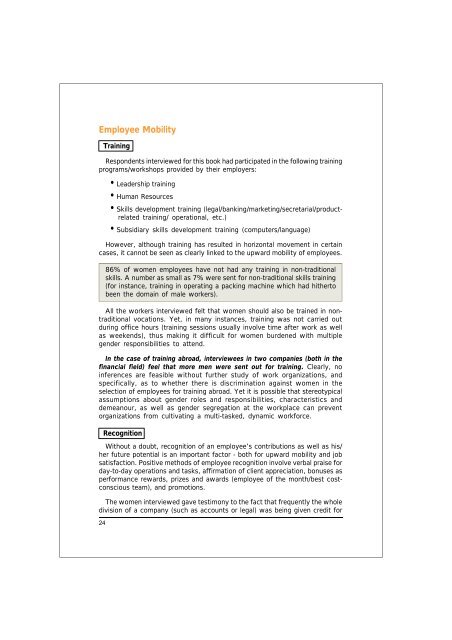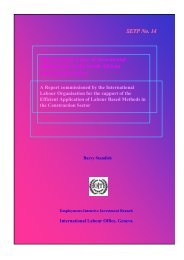Beyond Glass Ceilings and Brick Walls - International Labour ...
Beyond Glass Ceilings and Brick Walls - International Labour ...
Beyond Glass Ceilings and Brick Walls - International Labour ...
You also want an ePaper? Increase the reach of your titles
YUMPU automatically turns print PDFs into web optimized ePapers that Google loves.
Employee Mobility<br />
24<br />
Training<br />
Respondents interviewed for this book had participated in the following training<br />
programs/workshops provided by their employers:<br />
• Leadership training<br />
• Human Resources<br />
• Skills development training (legal/banking/marketing/secretarial/productrelated<br />
training/ operational, etc.)<br />
• Subsidiary skills development training (computers/language)<br />
However, although training has resulted in horizontal movement in certain<br />
cases, it cannot be seen as clearly linked to the upward mobility of employees.<br />
86% of women employees have not had any training in non-traditional<br />
skills. A number as small as 7% were sent for non-traditional skills training<br />
(for instance, training in operating a packing machine which had hitherto<br />
been the domain of male workers).<br />
All the workers interviewed felt that women should also be trained in nontraditional<br />
vocations. Yet, in many instances, training was not carried out<br />
during office hours (training sessions usually involve time after work as well<br />
as weekends), thus making it difficult for women burdened with multiple<br />
gender responsibilities to attend.<br />
In the case of training abroad, interviewees in two companies (both in the<br />
financial field) feel that more men were sent out for training. Clearly, no<br />
inferences are feasible without further study of work organizations, <strong>and</strong><br />
specifically, as to whether there is discrimination against women in the<br />
selection of employees for training abroad. Yet it is possible that stereotypical<br />
assumptions about gender roles <strong>and</strong> responsibilities, characteristics <strong>and</strong><br />
demeanour, as well as gender segregation at the workplace can prevent<br />
organizations from cultivating a multi-tasked, dynamic workforce.<br />
Recognition<br />
Without a doubt, recognition of an employee’s contributions as well as his/<br />
her future potential is an important factor - both for upward mobility <strong>and</strong> job<br />
satisfaction. Positive methods of employee recognition involve verbal praise for<br />
day-to-day operations <strong>and</strong> tasks, affirmation of client appreciation, bonuses as<br />
performance rewards, prizes <strong>and</strong> awards (employee of the month/best costconscious<br />
team), <strong>and</strong> promotions.<br />
The women interviewed gave testimony to the fact that frequently the whole<br />
division of a company (such as accounts or legal) was being given credit for
















